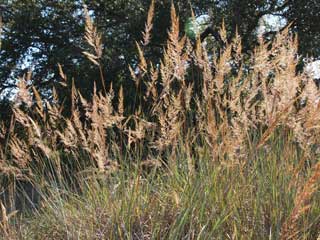Indian Grass
What is Indian Grass?
Indian Grass is a tall grass, that has a yellowish, almost golden appearance. It can grow anywhere from 3"-8" inches high and is normally found in large fields. Typically, the yellow Indian Grass consists of bunches of flowing culms and leaves. The culms can appear to be light green to pale yellow. The blades of the alternate leaves can spread 2" long across, and appear a dull green to dark green color.
The blooming period normally occurs during late summer and early fall. This is when the have a golden appearance and the branchlets of the pancile spread outward slightly. Afterwards, they become more appressed and ascending.

Cultivation.
The preference is full to partial sun and slightly moist to dry conditions. Various kinds of soil are tolerated, including those that can loam, clay-loam, sand, and gravel. Most growth and development occurs during the warm weather of summer because of the C4 metabolism of this grass. It can spread aggressively in some situations (e.g., prairie restorations).
Range and Habitat.
This common grass can be found in every county of Illinois (see Distribution Map). It was one of the dominant grasses of the prairies that covered much of Illinois during historical times. Habitats include savannas and sandy savannas, black soil prairies, clay prairies, sand prairies, gravel prairies, dolomite prairies, hill prairies, cemetery prairies, barrens with scrubby vegetation, limestone glades, grassy fens, fallow fields, roadsides, and areas along railroads (particularly where prairie remnants occur). Indian Grass is often used in tall grass prairie restorations.
Fanual associations
Several species of grasshoppers feed on the foliage of Indian Grass (see Grasshopper Table); these grasshoppers are an important source of food to many insectivorous song birds and upland game birds. Other insects that feed on this prairie grass include the leafhopper Flexamia reflexus, the planthopper Myndus fulvus, the Issid planthopper Bruchomorpha extensa, and the caterpillars of Amblyscirtes hegon (Pepper-and-Salt Skipper). The foliage is also palatable to hoofed mammalian herbivores, including bison and cattle. Because of its height and tendency to remain erect, it provides good cover for many kinds of birds and animals in prairies.
Final comments.
This tall prairie grass is attractive, particularly while the florets are blooming. It remains erect throughout the summer and even during the winter. Another dominant prairie grass, Andropogon gerardii (Big Bluestem), is more likely to lean in the direction of the prevailing winds, and its culms topple over during the winter to smother surrounding vegetation. Indian Grass is easy to identify because of its height and distinctive golden-colored inflorescence. It is distantly related to Sorghum spp. (Sorghums) of the Old World, including the introduced Sorghum halepense (Johnson Grass).
